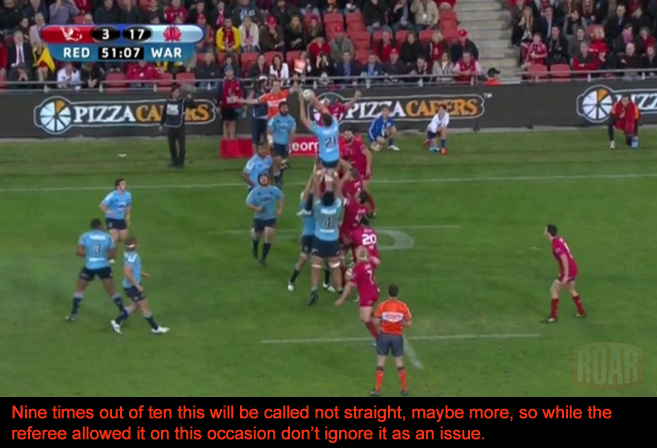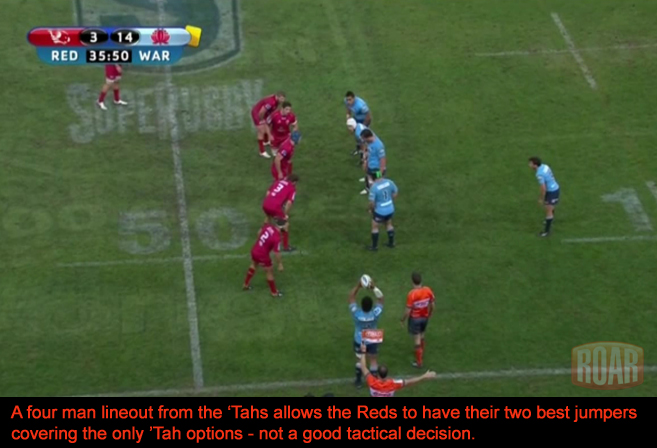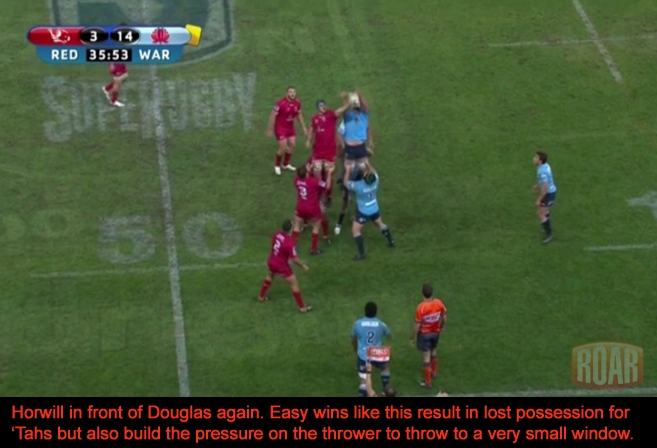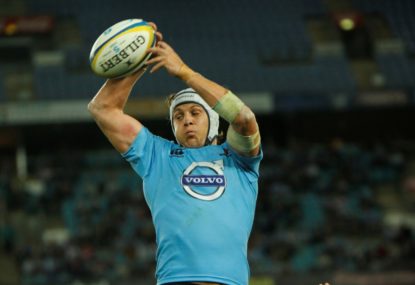Captain Obvious will say that the Waratahs cannot win the Super Rugby title unless they win their next two matches.
Others might say that they can’t win the title without Israel Folau, but while his unavailability through injury or any other reason would be a blow, it wouldn’t necessarily be the end of the ‘Tahs hopes.
There are of course five other teams that could have a say in stopping the Tahs.
The preferred outcome for the Tahs in this weekend’s matches would be for the Highlanders to get up and then have to travel back to Sydney for the semi-final the following weekend. The Tahs would then benefit from the impact of travel on the Highlanders and would go into that match having comfortably accounted for the same team just weeks ago.
If the Highlanders don’t win (and I don’t think they will) the Tahs face a stronger challenge from either the Brumbies or Chiefs.
Despite a good last-up performance from the Brumbies I’m probably leaning toward the Chiefs, with Aaron Cruden looking to be back in top form. Matt Toomua will have a big say for the Brumbies – he was superb against the Force.
If the Tahs get through their semi-final they’ll get the benefit of a home final, where they’ll likely face the Crusaders.
However, without discounting the other teams, the biggest area of concern for the Tahs in their next matches will be their lineout, which was significantly weakened by the loss of Dave Dennis, but if they produce another performance in this area like they did against the Reds they won’t win the title or even make the final.
Michael Cheika made the point that it was a terrible performance from his own team but that credit should go to the Reds for their excellent work in applying so much pressure. The Tahs could come up against teams in the finals who can apply just as much pressure as the Reds did, particularly the Brumbies and Crusaders. Rob Simmons and Ben Mowen are very good lineout defenders, but Sam Whitelock for the Crusaders is even better.
The Waratahs have to focus on what they can do better in their lineouts rather than making allowances for outstanding performances from the opposition.
The first step in that process is to understand what went so wrong against the Reds. Questions that need to be considered include: was it an issue with throwing; did the inclusion of Will Skelton in the starting team cause issues; and was it an issue with Stephen Hoiles as the caller?
If you look at the published statistics from the match, the Waratahs lost six of their own lineouts and won eight (57 per cent).
If you look beyond those numbers the real results are even more concerning. From those fourteen lineouts, the Waratahs really only won six (43 per cent) and only got clean ball to attack from three of the fourteen lineouts (21 per cent). They should have had another clean ball, so I claim four from fourteen (29 per cent).
Why the discrepancy in my numbers? In some matches the referee gets all the calls right, in others some calls will go for you and some against you. I prefer to look at what actually happened to ascertain what the real issues are, as you can’t make good decisions by allowing for referee errors.
The two additional losses I recorded came from a lineout in the ninth minute, when Wycliff Palu tapped the ball back under pressure and it went into touch. The assistant referee saw this and raised his flag for a Reds lineout throw, but the referee awarded a scrum to the Tahs for a Reds knock on. This is recorded as a win in the published statistics, but even if there was a Reds hand involved I’d still class that as a loss for the Tahs as the Reds got to the ball first but then lost it themselves.
The second came in the 52nd minute, where the throw was clearly not straight as shown below but was allowed by the referee. That’s likely to be called not straight nine times out of ten, so I wouldn’t make decisions based on that being a win.

The difference in clean ball numbers comes from Hoiles being interfered with in the air by James Horwill. That would also normally be penalised. While the Tahs won the lineout, Horwill denied the opportunity to play with clean ball so that wasn’t an issue caused by the Tahs and I adjusted my numbers accordingly.
The decision to award a penalty against the Tahs in the 61st minute for ‘truck and trailer’ interference from the maul was incorrect but that doesn’t affect the numbers as it was a clean win from that lineout.
Of the eight losses I recorded, three came from the throw not being straight. Eleven straight throws from fourteen (79 per cent) isn’t good enough, but in isolation it’s not disastrous.
Another loss came from a timing error when replacement hooker Silatolu Latu threw the ball too early before Hoiles was in position to jump. While not a good outcome, when replacements are made there can be some timing issues.
While the throwing wasn’t too bad that is a total of four lineouts from fourteen lost due to throwing errors, which accounts for 50 per cent of the losses, so it is the single biggest area that needs to be fixed.
Three losses were clean wins by the Reds where their jumper got to the ball before the Tahs, and another was the lineout where there is some uncertainty whether the Reds or Tahs got to the ball first and knocked it down.
Cheika said teams have worked out the Tahs calls, which meant the Reds knew where to defend. To counter that he said the Tahs will need to make some minor call adjustments. We know coaches are never going to tell journalists or the public exactly what’s going on, but let’s take a closer look to see if the Reds had cracked the Tahs’ code.
In nine of the fourteen lineouts the Reds jumper did get up in a direct contest against the Tahs jumper, which suggests the Reds knew where the ball was to be thrown. But was that because they had worked out the calls or were reading the movement of the Tahs players?
Having looked very closely at each of the lineouts, the Reds hadn’t worked out the lineout calls. There were three lineouts where the Reds didn’t get up and two where they were late up. In one of the nine lineouts where the Reds competed hard, they actually went up to defend the wrong jumper but still managed to put pressure on the next jumper in the line. They clearly didn’t know the call in those six lineouts.
There isn’t a single lineout where the Reds moved once Hoiles had made his call. In every lineout their movement was in reaction to movement by the Tahs players, not the call.
I’ll show you three lineouts to look at how the Reds were able to compete so effectively.
The way players defend in lineouts depends on a number of factors: tactical decisions on where to compete; the capabilities of defensive jumpers; how the opposition are set up; and whether the jumper is defending in the front, middle or back of the lineout.
The first example is a seven-man lineout in the ninth minute of the match. The Tahs opt for a full lineout with a 3-1-3 structure (a pod of three at the front, a single player in the middle and another pod of three at the back).
With a full pod of three in position at the front of the lineout, the Reds commit a pod of three to oppose them to take away the option of an easy win at the front. Jake Scahtz is jumping against Wycliff Palu and that’s where the throw would go on this occasion.
As you can see in the image below, Schatz was watching the thrower rather than Palu or his lifters. He was planning on going up no matter where the throw went and started his jump as soon as Tatafu Polota-Nau moved his arms back to start his throwing motion.

The options when defending at the front of the lineout are to: watch the thrower as Schatz did in this example; use your peripheral vision to watch the jumper’s movement and the thrower; or watch the jumper and their lifters. That decision is either a tactical decision or based on whether the opposition set up with a pod ready to go up at the front without any movement.
With the Tahs having a pod set up at the front, there was no need to consider movement of the jumper and it should have been defended the way Schatz did.
While people often say the safe throw is to the front, this is a perfect example of why that’s not the case. The Tahs would have known Scahtz is a good jumper and is quick off the ground. Palu is a solid jumper but isn’t that quick off the ground, so unless Scahtz made a mistake, he should have been able to get up at the same time as Palu and the best the Tahs would get is a closely contested throw.
That’s exactly what happened and the outcome was a loss for the Tahs. Whether Palu or Schatz got to the ball is debatable – the referee thought it was Schatz and the assistant thought it was Palu. The Tahs got the scrum feed for a knock-on but the aim of a lineout is to win the ball to use, not get into a tight contest like this and then hopefully get a scrum from an opposition error.

This was a calling error from Hoiles. When the front defender is set to go up like this, options in the middle or at the back of the lineout offer a better chance of winning clean ball. Why call into a tight contest like this was always going to be?
When we look at the next example, which was the first lineout of the match, the same seven-man structure was used.
Kane Douglas was out on his own but before he could be an option as a jumper he needed lifters, and the defenders could work out where the ball was going based on what the potential lifters did.
Michael Foley is a really good lineout coach and he says that defenders in the middle of the lineout should focus heavily on watching what the third and third-last players in the lineout do. There are some ways to defeat this theory by using movement and fakes, but for the vast majority of full lineouts this holds true.
In this example the third man was Skelton and the third-last man was Hoiles. Opposing them were James Slipper at the front and Simmons at the back.
Douglas couldn’t be a jumper unless Skelton moved to him and became the front lifter, so Slipper had to watch Skelton’s movement and react to him.
Douglas also needed a rear lifter, so Simmons watched Hoiles. If he moved forward, Hoiles would either be a lifter for Douglas or if Hooper was to follow him forward he could be the jumper with Douglas turning to become the front lifter. Regardless of what role Hoiles was to play, Simmons knew he had to move forward as that’s where the ball was likely to go.

Horwill was directly opposite Douglas and knew that once Skelton and Hoiles moved towards Douglas, either Douglas or Hoiles would be the jumper and regardless of which it was, Horwill would be the jumper to oppose them with Slipper as his front lifter and Simmons at the rear.
The call from Hoiles was for Douglas to go straight up and it became a pretty simple race between the lifters from each team to get to Douglas and Horwill. With the lifters having a fair amount of ground to cover, there was plenty of time for the Reds to get in position to defend this.
While this was the first lineout of the match, so the Tahs would have wanted to keep it pretty simple, they also would have known that the Reds have a good lineout so I’m surprised they thought this call would result in anything but a tight contest, which it did with Horwill achieving a clean steal in front of Douglas.

There are a number of ways to thwart the Reds defence in this structure. The simplest variation would have been for Skelton to move to Douglas as the front lifter, as he did. If Slipper didn’t follow him then Douglas would be lifted and as Horwill wouldn’t have had a front lifter, it should have been an easy win.
If Slipper followed Skelton, as he did, an override call would be used with Skelton stepping out of the lineout and Douglas moving quickly forward as the rear lifter for Palu at the front. It would have been hard for Slipper to turn quickly enough to counter this, so Schatz wouldn’t have had a rear lifter in place which should have resulted in an easy throw for Polota-Nau to Palu at the front.
In the third example, the Tahs went with a four-man lineout, with Douglas as the front jumper and Hoiles behind him as the other option. Opposing them were Horwill at the front and Simmons behind.
Using a four-man lineout was a tactical mistake – it gave the Reds an immediate advantage as Horwill and Simmons are better jumpers than the players they were defending against. It also limited the options the Tahs could use to outmanoeuvre the Reds on the ground.

The Reds’ best option with that structure was to get Horwill up, regardless of which jumper the Tahs called to. If the call was to Douglas, Horwill would be up in direct competition. If the call was to Hoiles, Horwill would be up in front of him and force Polota-Nau to make a tricky throw.
On this occasion Hoiles called it to Douglas. Horwill got off the ground before and in front of him. For a good lineout defender, it was too easy.

In nine of the fourteen lineouts in this match the Waratahs used no movement or fakes, other than the movement of the lifters to go to the jumper, and they lost six of those nine lineouts. When they used some movement they won three of five lineouts.
Poor tactics are letting the Tahs lineout down. A lineout with three or four good, quick jumpers as options doesn’t have to use as much movement, but the Tahs don’t have that.
While tactics and calling on-field are pretty closely aligned, it’s not a calling issue alone. The Waratahs should have gone into this match, and will need to go into their finals matches, with much better tactics to get their jumpers into the air before the opposition jumpers.
They need to determine who are the key defenders they’ll be up against and go in with a good tactical plan to move them out of position, not rely on beating the opposition into the air with speed alone.
I’m not suggesting that the ‘Tahs need to be too fancy with their lineouts. The movement options they used against the Reds were reasonable – they just need to use one of these options in every lineout.




































































































